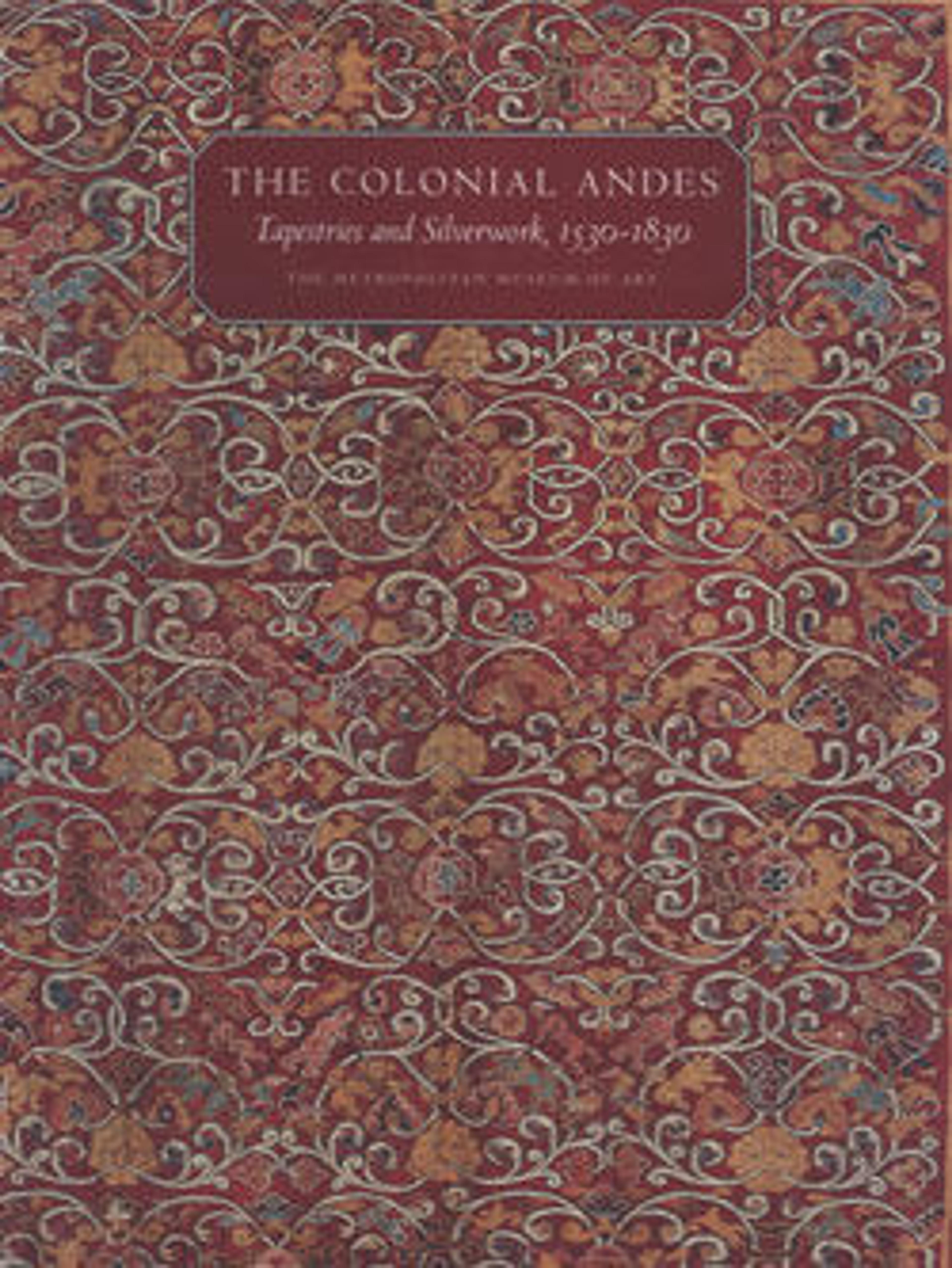Kero (beaker)
Wooden beakers, known as keros in Quechua, were the primary vessels for Inca libation rites. In Peru’s Viceregal period (1542–1824 CE), Inca identity remained strategically important among Indigenous elites, who were granted favorable concessions by colonial authorities based on their connections to Inca royal lineages. Some colonial keros continued to be made following traditional Inca geometric designs, while others were stylistically innovative, introducing colorful figurative motifs and complex scenes inspired by an idealized Inca history and traditions (see, for example, MMA 1994.35.14, .15, .16). This beaker, one of a pair (with MMA 1994.35.19), maintains the classic Inca kero cylindrical shape that flares at the top but is considerably narrower in the middle than the typical Inca vessel. In addition, the geometrical designs made with tin studs on the bottom, middle, and top as well as the two circular bands around the middle indicate the influence of the Spanish conquerors.
Often crafted and used in pairs, keros imply the need for a drinking partner, underscoring the social and political nature of these rituals. Elaborate toasts were a key part of Inca ceremonies, and toasting, be it with huacas (enlivened, sacred entities of the landscape), ancestors, or other community members, was the Andean way to establish and maintain relationships (Cummins, 2002). Filled with a maize beer known as chicha, these vessels were prominent visual features of any gathering of significance in the Inca Empire. Indeed, art historian Tom Cummins (2002: 39) has pointed out that in Andean feasts drinking was more important than eating. Such exchanges were occasionally depicted by Inca artists, such as one shown on a copper tumi (a type of knife with a curved blade; see Emmerich and Lapiner, 1969: pl. 56 and Lapiner, 1976: 319).
Further Reading and References
Cummins, Thomas B. F. Toasts with the Inca: Andean Abstraction and Colonial Images on Quero Vessels. Ann Arbor: University of Michigan Press, 2002.
Emmerich, André, and Alan Lapiner. Sun Gods and Saints: Art of Pre-Columbian and Colonial Peru. Exh. cat. New York: Andre Emmerich Gallery, 1969.
Kusunoki, Ricardo, Cecilia Pardo and Julio Rucabado. Los incas. Más allá de un imperio. Lima: Museo del Arte, 2023.
Lapiner, Alan. Pre-Columbian Art of South America. New York: Harry N. Abrams, 1976.
Ochoa, Jorge F., Elizabeth K. Arce, and Roberto S. Argumedo. Queros: Arte Inka en vasos ceremonials. Lima: Banco de Crédito, 1998.
Pearlstein, Ellen J., Emily Kaplan, Ellen Howe, and Judith Levinson. "Technical Analyses of Painted Inka and Colonial Qeros." Objects Specialty Group Postprints 6 (2000), pp. 1999-2000.
Shimada, Izumi, ed. The Inka Empire: A Multidisciplinary Approach. Austin: University of Texas Press, 2015.
Often crafted and used in pairs, keros imply the need for a drinking partner, underscoring the social and political nature of these rituals. Elaborate toasts were a key part of Inca ceremonies, and toasting, be it with huacas (enlivened, sacred entities of the landscape), ancestors, or other community members, was the Andean way to establish and maintain relationships (Cummins, 2002). Filled with a maize beer known as chicha, these vessels were prominent visual features of any gathering of significance in the Inca Empire. Indeed, art historian Tom Cummins (2002: 39) has pointed out that in Andean feasts drinking was more important than eating. Such exchanges were occasionally depicted by Inca artists, such as one shown on a copper tumi (a type of knife with a curved blade; see Emmerich and Lapiner, 1969: pl. 56 and Lapiner, 1976: 319).
Further Reading and References
Cummins, Thomas B. F. Toasts with the Inca: Andean Abstraction and Colonial Images on Quero Vessels. Ann Arbor: University of Michigan Press, 2002.
Emmerich, André, and Alan Lapiner. Sun Gods and Saints: Art of Pre-Columbian and Colonial Peru. Exh. cat. New York: Andre Emmerich Gallery, 1969.
Kusunoki, Ricardo, Cecilia Pardo and Julio Rucabado. Los incas. Más allá de un imperio. Lima: Museo del Arte, 2023.
Lapiner, Alan. Pre-Columbian Art of South America. New York: Harry N. Abrams, 1976.
Ochoa, Jorge F., Elizabeth K. Arce, and Roberto S. Argumedo. Queros: Arte Inka en vasos ceremonials. Lima: Banco de Crédito, 1998.
Pearlstein, Ellen J., Emily Kaplan, Ellen Howe, and Judith Levinson. "Technical Analyses of Painted Inka and Colonial Qeros." Objects Specialty Group Postprints 6 (2000), pp. 1999-2000.
Shimada, Izumi, ed. The Inka Empire: A Multidisciplinary Approach. Austin: University of Texas Press, 2015.
Artwork Details
- Title:Kero (beaker)
- Artist:Peruvian artist(s)
- Date:Early 17th century
- Geography:Peru
- Culture:Quechua
- Medium:Wood, tin, pigment, resin
- Dimensions:H. 8 1/2 × W. 7 1/4 × D. 7 1/4 in. (21.6 × 18.4 × 18.4 cm)
- Classification:Wood-Containers
- Credit Line:Bequest of Arthur M. Bullowa, 1993
- Object Number:1994.35.18
- Curatorial Department: The Michael C. Rockefeller Wing
More Artwork
Research Resources
The Met provides unparalleled resources for research and welcomes an international community of students and scholars. The Met's Open Access API is where creators and researchers can connect to the The Met collection. Open Access data and public domain images are available for unrestricted commercial and noncommercial use without permission or fee.
To request images under copyright and other restrictions, please use this Image Request form.
Feedback
We continue to research and examine historical and cultural context for objects in The Met collection. If you have comments or questions about this object record, please contact us using the form below. The Museum looks forward to receiving your comments.
